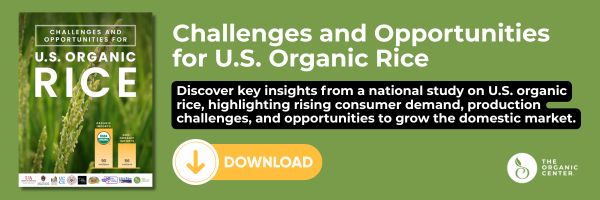Top 5 Opportunities for U.S. Organic Rice
Organic rice is a rising star in the U.S. food system, but despite growing consumer demand and high price premiums, most of it still comes from overseas. A new multistate study led by The Organic Center, Challenges and Opportunities for U.S. Organic Rice, reveals why--and more importantly--how we can change that.
This blog highlights the Top 5 Opportunities for U.S. Organic Rice, from expanding domestic production to reducing risk for farmers and building stronger local markets. Whether you're a policymaker, buyer, or advocate, the findings offer a roadmap for reshaping the future of organic rice.
Tap Into Existing U.S. Strengths
The U.S. has the climate, infrastructure, and knowledge to grow high-quality rice, yet imported organic rice dominates the market. By supporting domestic transition, demand can be met with homegrown supply.
Make Organic Less Risky for Farmers
Organic growers often face uncertainty and fewer financial safety nets. Adapting crop insurance and support programs to reflect the realities of organic farming can reduce risk and encourage more farmers to make the switch.
Expand Market Access in Key Regions
Many farmers, especially in rice-heavy states like Arkansas, lack connections to organic buyers. Building local marketing networks can bridge this gap and create more reliable pathways to market.
Speak Farmers’ Language
Farmers value profitability and land stewardship. Framing organic rice as a business opportunity with environmental benefits can drive broader interest and adoption.
Boost Outreach and Technical Support
With better education, peer-to-peer learning, and region-specific resources, more farmers could see organic as a viable path forward.


